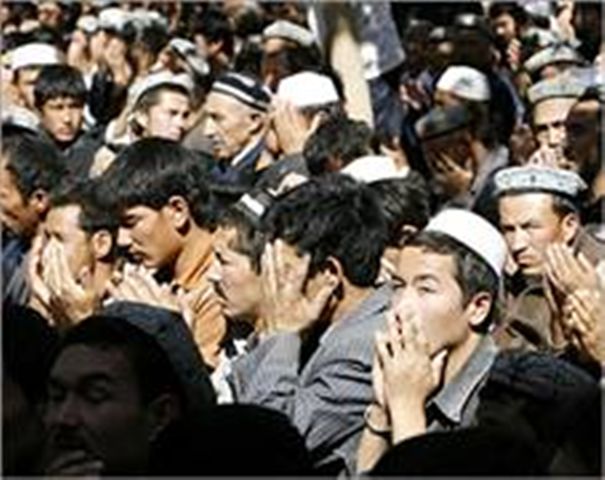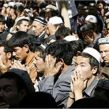
Turkistan Islamic Party Video Attempts to Explain Uyghur Militancy to Chinese
Publication: Terrorism Monitor Volume: 9 Issue: 25
By:

Almost completely overshadowed by the death of Osama bin Laden, jihadi publishing house Sawt al-Islam released a bilingual video from the Turkistan Islamic Party in mid-May. [1] The video recounted various historic grievances held by western China’s Muslim Uyghur people against Chinese communist rule while promising new efforts to achieve the independence of “East Turkistan” (China’s western province of Xinjiang). While the substance of the video is not that novel, the fact that it has been released with a narration in Mandarin Chinese would seem to mark a new twist for TIP, a group that has thus far largely restricted itself to publishing magazines in Arabic with occasional videos in Uyghur.
The video is delivered bilingually, with a speaker identified as Faruq Turisoon speaking Mandarin in the flat tones typical of some Chinese minorities. The language he uses is fluent and rapid, demonstrating a level of linguistic capability that would suggest he has at least lived in Chinese speaking communities for some time. The Uyghur version is dubbed over the Mandarin, while the Mandarin version has subtitles in simplified Chinese characters similar to those commonly used in Chinese television and cinema.
During the course of the video we see Turisoon standing before a group of eight heavily armed men brandishing machine guns and rocket propelled grenade launchers, with two men on horseback flying the black flag of jihad and the traditional blue flag of East Turkistan. The video is interspersed with footage from Abu Yahya al-Libi’s October 2009 video called “East Turkistan: the Forgotten Wound,” that was released in the wake of the rioting in Xinjiang in July 2009 (ansar1.info, October 7, 2009). The new video also contains footage of unknown men in Middle Eastern garb talking about the situation in China on television and what appears to be footage from a release by al-Qaeda in Iraq in response to the 2009 riots.
The video is in the format of a “Letter to the Chinese People,” laying out Uyghur claims for independence and freedom for East Turkistan from the Chinese state (the region was independent of China for brief periods in the 1900s). In his speech, Turisoon repeatedly invokes China’s experience with Japan to make the Chinese people understand Uyghur perceptions of their treatment at the hands of the Chinese.
Turisoon cites the Cultural Revolution (the 1966-1976 period when Mao unleashed a purge of capitalist elements that ripped China apart) and Tiananmen Square (the June 1989 incident when the People’s Liberation Army cleared Beijing of protesting students) as incidents of when the Chinese government “wantonly killed” its own people. Added to this list he includes the rioting in the Xinjiang capital of Urumqi in July 2009 that left around 200 people dead (of both Han Chinese and Uyghur ethnicity) and an uncertain number of Uyghurs incarcerated or executed subsequently.
Within the context of Uyghur complaints, his statements are quite traditional, and in the video he highlights well-known Uyghur grievances with Chinese government family planning policies, the large-scale immigration of Han Chinese to Xinjiang and the supposed emigration of Uyghur women from Xinjiang to other provinces. [2] He also discusses the exploitation of Xinjiang’s natural resources by the Chinese government and singles out the work of the Xinjiang Production and Construction Corps (XPCC), a group founded subsequent to the Communist Party’s take-over of Xinjiang using demobilized Chinese soldiers to establish a foothold in the province. The XPCC still controls much of the province’s economy.
The exact reason for releasing the video now is unclear. In the weeks prior to its publication, a report in the Pakistani press claimed that Abdul Shakoor al-Turkistani, the supposed chief of the TIP, was elevated to the role of “chief of [al-Qaeda] operations in Pakistan,” so it is possible that this video was a reflection of a new push by the group to assert itself (The News [Islamabad], May 21). However, given the relatively low interest that al-Qaeda or any other groups have shown thus far in the plight of the Uyghurs and the close security connection between China and Pakistan that has likely stymied Uyghur groups’ efforts to carry out any attacks, it would be surprising if the release of this single video made much of an impact. During a visit last year to Beijing, Pakistani Interior Minister Rehman Malik confirmed the death of Abdul Haq al-Turkistani, the former leader of the East Turkistan Islamic Movement (ETIM – an alleged predecessor of the TIP), and declared that they had “broken the back” of the ETIM (Dawn, May 7, 2010; see also Terrorism Monitor, March 11, 2010).
It should be noted that at around the same time as the alleged meetings were taking place in which Abdul Shakoor al-Turkistani was elevated to his new role, the Shanghai Cooperation Organization (SCO) undertook a counterterrorism operation along the Kyrgyz-Tajik-Chinese border northwest of Kashgar in Xinjiang. The exercise took the format of forces hunting down a training camp on the Chinese side of the border and rescuing a bus full of hijacked citizens. Commenting subsequently, Vice Minister of Public Security Meng Honwei declared that there were “signs [that] the ‘East Turkistan’ terrorists are flowing back….the drill was designed against the backdrop that they are very likely to penetrate into China from Central Asia” (China Daily, May 9).
The video received no coverage in the Chinese media (or anywhere else for that matter), likely a reflection of a Chinese official desire to keep the information out of public circulation, but also due in part to the fact that the Turkistan groups have largely failed to conduct any successful attacks and remain low-level players in the world of global jihadism. Aside from some (disputable) claims of responsibility for small-scale and low-tech efforts to attack buses or airplanes in China, the group has not particularly demonstrated a capacity to carry out terrorist attacks within China or beyond.
Nevertheless, documents released by Wikileaks concerning suspected Uyghur militants detained in Guantanamo show that there is a contingent that has in the past moved from China to training camps in Central Asia in response to the oppression they believed they faced. [3] When one couples this with the ongoing tensions between Uyghurs and Han Chinese that are clearly visible in parts of Xinjiang, it is easy to visualize the sort of potential for threat that exists. Whether this video in Mandarin is a direct threat that presages action is unclear, but it certainly shows the groups eagerness to continue to prove its existence.
Notes:
1. https://majahden.com/vb/showthread.php?t=17424.
2. The phenomenon was described by Abu Yahya al-Libi in his October 6, 2010 video, “East Turkistan: The Forgotten Wound” (al-Fajr Media Center). Abu Yahya denounced “the forced displacement and transport of Muslim girls to the major inner cities of China. These girls are cut off from their families for many years, perhaps forever, under the guise of vocational training so that they are able to work in factories and elsewhere (so these atheists claim). Indeed, hundreds of thousands of these girls were displaced to drown in the sea of corruption, godlessness, longing for their homeland, and organized capture and dishonorable employment. This has left many Muslim women with no choice other than to kill themselves in order to escape the cursed law.”
3. See the Guantanamo records of Uyghur prisoners at https://www.wikileaks.ch/gitmo/country/CH.html.





